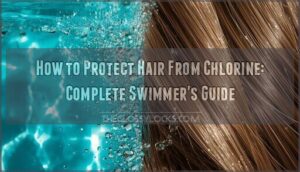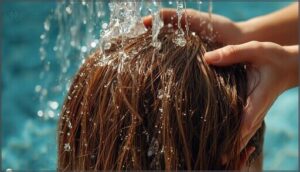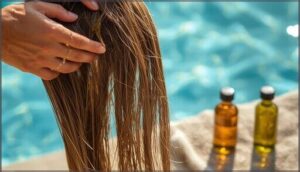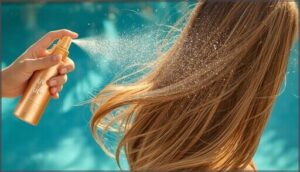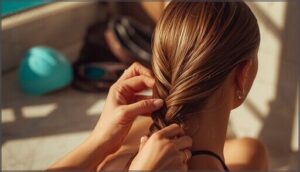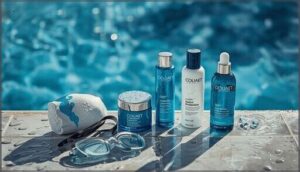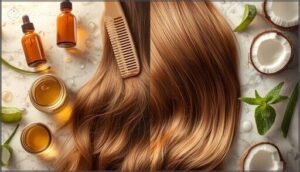This site is supported by our readers. We may earn a commission, at no cost to you, if you purchase through links.
Chlorine keeps pools clean, but it treats your hair like a chemical experiment gone wrong. Every lap you swim exposes your strands to a harsh oxidizing agent that strips away the protective oils your scalp naturally produces. The result? Dry, brittle hair that tangles easily, breaks without warning, and sometimes takes on an unwanted greenish tint.
Swimmers don’t have to choose between their passion for the pool and healthy hair, though. With the right protective strategies before you jump in and proper care after you towel off, you can keep your hair strong and vibrant all season long.
Table Of Contents
Key Takeaways
- Chlorine strips your hair’s natural oils and breaks down keratin proteins, weakening strands by up to 63% in just six days and causing dryness, breakage, and unwanted color changes.
- Pre-swim protection—saturating hair with clean water, applying coconut or argan oil, and wearing a silicone swim cap—cuts chlorine absorption by up to 70% and prevents most damage before it starts.
- Rinse within 15 minutes of leaving the pool and use clarifying or chelating shampoos weekly to remove chlorine buildup, then follow with deep conditioning treatments to restore moisture and protein.
- Daily swimmers need a consistent routine combining pre-swim barriers, immediate post-swim cleansing, weekly deep conditioning, and regular trims every 6-8 weeks to maintain healthy hair.
How Chlorine Damages Hair
Chlorine doesn’t just leave your hair feeling dry—it actually breaks it down from the inside out. Understanding how chlorine harms your hair helps you protect it before the damage starts.
Here’s what happens when chlorine comes in contact with your strands.
Stripping Natural Oils and Moisture
When chlorine strips your hair’s lipid barrier, it’s pulling away the natural oils—including sebum—that normally lock in hair moisture. Think of it like removing the seal on a water bottle. Without that protective layer, moisture depletion happens fast.
Your hair absorbs too much water, leading to swelling effects, then dries out completely. The result? Brittle strands, scalp dryness, and persistent hair dryness that’s tough to reverse. Chlorine can also cause unwanted hair discoloration.
Weakening Hair Structure and Cuticles
Beyond moisture loss, chlorine weakens your hair shaft from the inside out. It triggers Cuticle Layer Degradation by lifting and breaking down those protective outer scales, exposing the inner cortex.
This leads to Keratin Protein Breakdown and a Tensile Strength Decrease—your hair strands can lose up to 63% of their strength after just six days of pool exposure, making hair breakage almost inevitable.
Chlorine breaks down keratin and weakens hair strands by up to 63% in just six days, making breakage nearly inevitable
Chlorine can also bind to keratin, a key protein in hair structure.
Changing Hair Color and Texture
As hair structure breaks down, you’ll notice pigment oxidation that dulls your natural color and can even trigger green hair from copper deposits in pool water. Chlorine discoloration is especially visible in blonde or color-treated strands, where texture alteration makes hair feel rough and look brassy.
This hair color change happens because chlorine strips both moisture and melanin, accelerating hair lightening. Your damage level determines how quickly these shifts occur—chemically processed hair shows the most dramatic hair texture and hair discoloration problems, while virgin hair resists longer but still fades over time.
Increasing Hair Porosity and Breakage
When those lifted cuticles let chlorine absorption reach your hair shafts, porosity skyrockets. Your strands drink up water but can’t hold it, creating a cycle of fiber weakening and protein loss that destroys hair elasticity.
This cuticle damage turns hair brittle, snapping easily during brushing or styling. Chlorine damage doesn’t stop at the surface—it penetrates deep, making hair breakage prevention essential for anyone who swims regularly.
Pre-Swim Steps to Protect Hair
The best defense against chlorine damage starts before you even step into the pool. A few simple steps can create a protective barrier that keeps your hair healthier and stronger throughout swim season.
Here’s what you need to do before getting wet.
Rinsing Hair With Clean Water
Think of your hair like a sponge—it soaks up whatever it touches first. Saturating every strand with clean tap water before you jump in limits how much chlorinated water can penetrate, protecting against dryness and damage.
Here’s how to best prepare with pre-swim saturation:
- Rinse for at least 60 seconds under running water
- Massage your scalp to reach roots and ends
- Squeeze out excess, but leave hair damp
- Repeat this routine consistently for lasting hair protection
Applying Natural Oils or Leave-in Conditioner
Once your hair is damp from pre-wetting, adding an oil barrier or leave-in conditioner locks in moisture and keeps chlorine at bay. Coconut oil penetrates deep into the hair shaft, while olive and argan oils coat the surface—both shield against chemical damage.
Apply a palm-sized amount to mid-lengths and ends, focusing on porous areas most prone to breakage.
| Oil Type | Best For |
|---|---|
| Coconut Oil | Deep penetration, all hair types |
| Olive Oil | Surface protection, fine to medium hair |
| Argan Oil | Shine and smooth texture, color-treated hair |
| Leave-in Conditioner | Lightweight barrier, easy application |
Using UV-Protective Sprays
After applying your oils, a UV-protective spray adds another layer of defense against sun damage that compounds chlorine stress. Benzophenone-based UV filter types preserve color and structure better than other formulations—spray application techniques matter, so mist evenly from roots to ends before heading poolside.
- Color preservation: UV filters reduce fading by over 20% in chemically treated hair
- Structural mitigation: Protects keratin bonds weakened by bleach or chlorine
- Formulation technologies: Nanostructured carriers deliver enhanced photoprotection
- Heat resistance: Maintains hair’s denaturation temperature under sun exposure
- All-day shield: Ideal for outdoor swimmers combining hair protection methods
UV-protective spray enhances your pre-swimming hair preparation routine, safeguarding hair health and swimming performance.
Securing Hair in Braids or Buns
Before you begin, twist or braid your hair into a compact bun to limit direct exposure to chlorinated water. This style’s effectiveness is proven: braids and buns reduce tangle formation, improve cap fit, and boost product retention across all hair types.
By containing hair strands, you minimize hair breakage along vulnerable hair shafts—a simple yet powerful addition to your hair protection methods that keeps hair protection practical.
Benefits of Wearing a Swim Cap
A swim cap acts like a shield between your hair and chlorinated water. It won’t keep your hair completely dry, but it greatly cuts down on chlorine exposure and damage.
Here’s what you need to know about making swim caps work for you.
Reducing Direct Chlorine Exposure
A swim cap cuts chlorine absorption by up to 70% when you wear it properly. Pre-wetting your hair and applying a barrier film like conditioner before pulling on the cap strengthens this defense. Chlorine absorption mechanisms show the cap limits direct contact between pool water and your cuticle, slowing protein damage.
Even with swim goggles protecting your eyes, the cap shields strands from UV impact and repeated oxidative stress in outdoor pools.
Choosing Silicone Vs. Latex Swim Caps
Silicone caps offer enhanced durability and comfort compared to latex, lasting several seasons versus just a few months under regular chlorine exposure. Material properties make silicone hypoallergenic and gentler on your scalp, while latex caps fit tighter and may trigger allergy concerns in sensitive swimmers.
Silicone’s thicker build improves thermal regulation in cold water, though latex breathes better in warm pools—both deliver solid swim cap protection.
Tips for Proper Swim Cap Use
Getting your swim cap on right makes all the difference in protecting hair from chlorine. Start with pre-cap hair prep—wet strands and add a bit of conditioner so the cap glides easily.
Stretch it wide with both hands, front-to-forehead first, then smooth back to avoid snagging. Tuck every strand under for full swim cap protection, and recheck after dives to keep that barrier tight.
Best Products to Shield Hair From Chlorine
You’ve got your technique down, but the right products make all the difference for keeping chlorine at bay. Think of them as your hair’s armor—a layer of defense that works while you’re doing laps.
Let’s look at what actually works to shield your strands from pool damage.
Leave-in Chlorine Protectants
With proper application timing—about 15 to 20 minutes before you hit the pool—leave-in conditioner creates a barrier function that blocks chlorine from stripping your hair. Key ingredients like silicones and ceramides support moisture retention and color preservation.
These hair treatment products work as your first defense in pre-swimming hair preparation, protecting hair from chlorine far better than water alone.
Coconut Oil, Olive Oil, and Argan Oil
Natural oils work differently than leave-ins—they don’t just coat, they protect at a deeper level. Coconut oil penetrates the hair shaft, reducing protein loss before chlorine strikes. Olive oil forms a surface barrier that slows chemical absorption. Argan oil repairs damage while shielding future swim sessions.
Apply these hair oils to damp mid-lengths and ends about ten minutes before swimming for maximum protection.
UV and Color-Protecting Sprays
UV-protective sprays promise to guard against sun damage and color fading—but real-world performance varies. Research shows many sprays struggle to deliver consistent coverage across every strand, especially when applied too lightly. For best results, mist your hair thoroughly before and after swimming, focusing on mid-lengths and ends.
- Spray efficacy: Look for products with proven UV filters and antioxidants
- Application techniques: Apply three light passes for even coating
- Protecting blonde hair: Choose purple-toning formulas to prevent brassiness
Post-Swim Hair Care Routine
Getting out of the pool isn’t the finish line—it’s where your real hair protection begins. What you do in those first few minutes can make all the difference between healthy, bouncy hair and a brittle, damaged mess.
Here’s your step-by-step post-swim routine to wash away chlorine and restore your hair’s natural strength.
Rinsing and Washing Out Chlorine
The moment you step out of the pool, the clock starts ticking—rinse your hair with fresh water within 15 minutes to dilute chlorine before it dries and digs deeper into each strand. Then follow up with a gentle shampoo that targets pool residues your hair rinse alone can’t lift.
| Step | Action | Why It Matters |
|---|---|---|
| Rinse first | Lukewarm fresh water for 2–3 minutes | Flushes out chlorinated water fast |
| Shampoo next | Swimmer-specific or mild formula | Removes lingering chemical films |
| Consider filters | Vitamin C shower filters at home | Cuts tap-water chlorine during washing |
Washing frequency depends on how often you swim—daily pool sessions mean daily post-swim shampoo, though you can adjust product strength and pair it with deep conditioning to avoid over-drying. If your tap water is heavily chlorinated, a dechlorinating shower filter reduces extra exposure every time you wash, keeping cumulative damage in check.
Using Clarifying and Chelating Shampoos
When regular shampoo won’t budge stubborn buildup, clarifying shampoo steps in with stronger surfactants to strip away chlorine residues—but chelating shampoo goes further, binding copper and other metals that cause green discoloration.
Use chelating formulas weekly if you swim often, clarifying versions once or twice monthly for lighter exposure.
Both intensify dryness, so always follow with a deep conditioner to protect hair integrity and lock in moisture.
Deep Conditioning and Moisturizing Treatments
After clarifying washes strip away buildup, deep conditioning treatments become essential—they restore hydration, rebuild protein bonds, and seal cuticles damaged by chlorine.
Apply a hair mask rich in keratin, ceramides, or amino acids from mid-lengths to ends weekly. Leave it on 10–15 minutes, letting humectants like glycerin lock in moisture.
Follow with coconut or argan oil to moisturize hair and scalp, reducing breakage while restoring elasticity.
Gentle Detangling and Air Drying
Wet combing can shift breakage patterns—water plasticizes fibers, making them more vulnerable to snapping under tension. Blot gently with a microfiber towel instead of rubbing to preserve cuticle integrity, then apply detangling agents before combing with a wide-tooth tool.
- Squeeze, don’t scrub: Vigorous towel drying roughens cuticles and increases hair damage.
- Use microfiber or soft T-shirts: They reduce friction compared to standard terry cloth.
- Apply leave-in conditioner first: Detangling agents lower combing force and minimize snags.
- Start from ends, work upward: Short strokes prevent severe breakage at crossover points.
- Skip heat exposure when possible: Air drying with prep products protects against thermal cuticle lifting.
Repairing and Treating Chlorine-Damaged Hair
Even with the best protection, chlorine damage happens. The good news is that you can restore your hair’s strength and shine with the right treatments.
Let’s walk through the steps to repair damage and bring your hair back to life.
Protein-Rich Masks and Treatments
Your hair needs protein to bounce back from chlorine damage, and protein-rich masks with keratin or amino acids rebuild those broken strands. Amino acid benefits include restored strength and elasticity, reversing chlorine damage effectively. Use these hair treatment products once or twice a week.
But watch for protein overload risks: if your hair feels stiff or brittle, you’ve overdone it. Balancing protein with moisture is key for actual hair repair.
Moisturizing Scalp and Hair Oils
Think of natural oils as your hair’s emergency repair crew after chlorine damage. They deliver lipid restoration, cuticle sealing, and scalp hydration your strands desperately need.
Here’s what works:
- Coconut oil cuts protein loss by 39% and boosts tensile strength by 25%
- Argan oil improves scalp moisture retention by 40% while regulating sebum
- Olive oil strengthens cuticles, reducing breakage by 22%
- Jojoba oil mimics natural sebum, restoring hydration by 45%
Apply these for effective oil penetration and real moisturizing results.
Remedies for Green or Discolored Hair
Green hair happens when copper from pool water oxidizes and binds to your damaged cuticles. Chelating shampoos containing iminodiacetic acid remove 30-40% of copper deposits after 20 washes.
For faster results, vitamin C treatments dissolve oxidized metal complexes in one salon session.
Tomato treatments work for mild green cast because their acidity loosens copper, though they’re messy and inconsistent compared to professional chelating products.
When to Seek Professional Help
Persistent symptoms like scalp itching beyond four weeks or visible inflammation signal contact dermatitis, not simple dryness.
Excessive breakage near the scalp, hair loss, or severe dryness that won’t respond to conditioners means you need a trichologist or dermatologist.
Color-treated concerns requiring salon correction and ineffective self-care after several weeks both indicate it’s time for professional hair and scalp health assessment.
Tips for Swimmers to Maintain Healthy Hair
You’ve learned how to protect and repair your hair, but keeping it healthy long-term means building smart habits into your routine.
Regular swimmers need a few key strategies to prevent damage before it starts. Let’s look at the essential practices that’ll keep your hair strong, shiny, and resilient no matter how often you hit the pool.
Establishing a Consistent Hair Care Routine
Consistency makes all the difference in protecting your hair from chlorine. Building a structured routine around every swim gives your hair the daily maintenance and protective habits it needs, preventing chlorine damage before it starts. Here’s how to create an effective hair care routine:
- Rinse before every swim to saturate hair with clean water and reduce chlorine absorption
- Apply a leave-in protectant daily before entering the pool for product integration
- Cleanse immediately after swimming with a gentle swimmer’s shampoo as part of your post-swim hair care routine
- Deep condition weekly to restore moisture and maintain hair health
- Schedule clarifying treatments 1-2 times per week based on routine frequency to remove buildup
Swimmers who stick to these hair care tips for swimmers notice stronger, healthier hair that withstands regular pool exposure.
Protecting Color-Treated and Blonde Hair
Color-treated and blonde hair needs extra defense because dyes increase color-treated porosity, making strands soak up more chemicals. That’s why copper in pool water creates green tones, especially visible on light hair.
Pre-swim barriers like coconut oil and leave-in conditioner cut absorption. Pair these with a silicone cap for swim cap effectiveness, then follow with post-swim repair using chelating shampoos to reverse damage and keep your color vibrant.
| Protection Step | Why It Works |
|---|---|
| Pre-wet + oil barrier | Blocks chlorine and copper uptake |
| Silicone swim cap | Reduces exposure by 30–50% |
| Chelating shampoo after | Removes green-causing metals |
Staying Hydrated for Hair Health
Although chlorine attacks from outside, hair hydration and health also depend on what you drink. Water intake aids nutrient delivery to follicles and maintains scalp hydration—about 25% of each strand is water.
Adding omega-3s improves hair elasticity and keeps strands flexible. When you’re dehydrated, hair becomes brittle and prone to breakage, so moisturizing from within strengthens your defense against pool damage.
Avoiding Heat Styling After Swimming
Because pool water already weakens your hair structure, blow dryers and flat irons can push damaged strands past their breaking point. Heat styling wet, chlorine-soaked hair risks bubble hair—tiny steam pockets that crack strands from within.
Air-dry benefits include less cumulative damage, and if you must style, use low-heat options with heat protectants to shield already compromised fibers.
Frequently Asked Questions (FAQs)
Can I swim daily without damaging my hair?
You can swim daily without serious hair damage if you follow protective steps consistently.
Swimmers using pre-swim barriers, swim caps, and post-swim care show 85% less texture or color changes over time.
Are salt water pools better for hair health?
Yes, saltwater pools are gentler on hair health. They strip 20-30% less sebum, preserve hair elasticity better, retain color longer, and cause considerably less scalp irritation than traditional chlorinated water.
How long does chlorine stay in hair untreated?
Free chlorine can linger on wet hair for 12–24 hours if not rinsed, while chloramine compounds remain bound to your hair shaft until you wash them out with clarifying shampoos.
Should I trim hair more often as a swimmer?
Regular exposure can accelerate split end progression and breakage. You’ll want trims every 6–8 weeks—about twice as often—to maintain hair strength, support growth retention, and prevent chlorine damage from climbing upward.
Conclusion
Prevention is worth a pound of cure for chlorine damage. Learning how to protect hair from chlorine doesn’t mean abandoning your swimming routine—it means building smart habits around it.
Wet your hair before diving in, apply protective oils, wear a proper swim cap, and never skip post-swim care. Your hair can handle the pool when you handle it with intention.
Strong, healthy strands and regular swimming can absolutely coexist.
- https://www.drfarole.com/blog/can-chlorine-pool-water-cause-hair-loss/
- https://bodybio.co.uk/blogs/blog/chlorine-exposure
- https://www.swimon.com/chlorine-and-your-hair-it-can-be-better/
- https://olaplex.com/blogs/news/post-pool-haircare-repair-hair-damage-from-chlorine
- https://elemntlife.com/blogs/swim-skincare/10-tips-on-how-to-protect-your-hair-from-chlorine-water-damage

